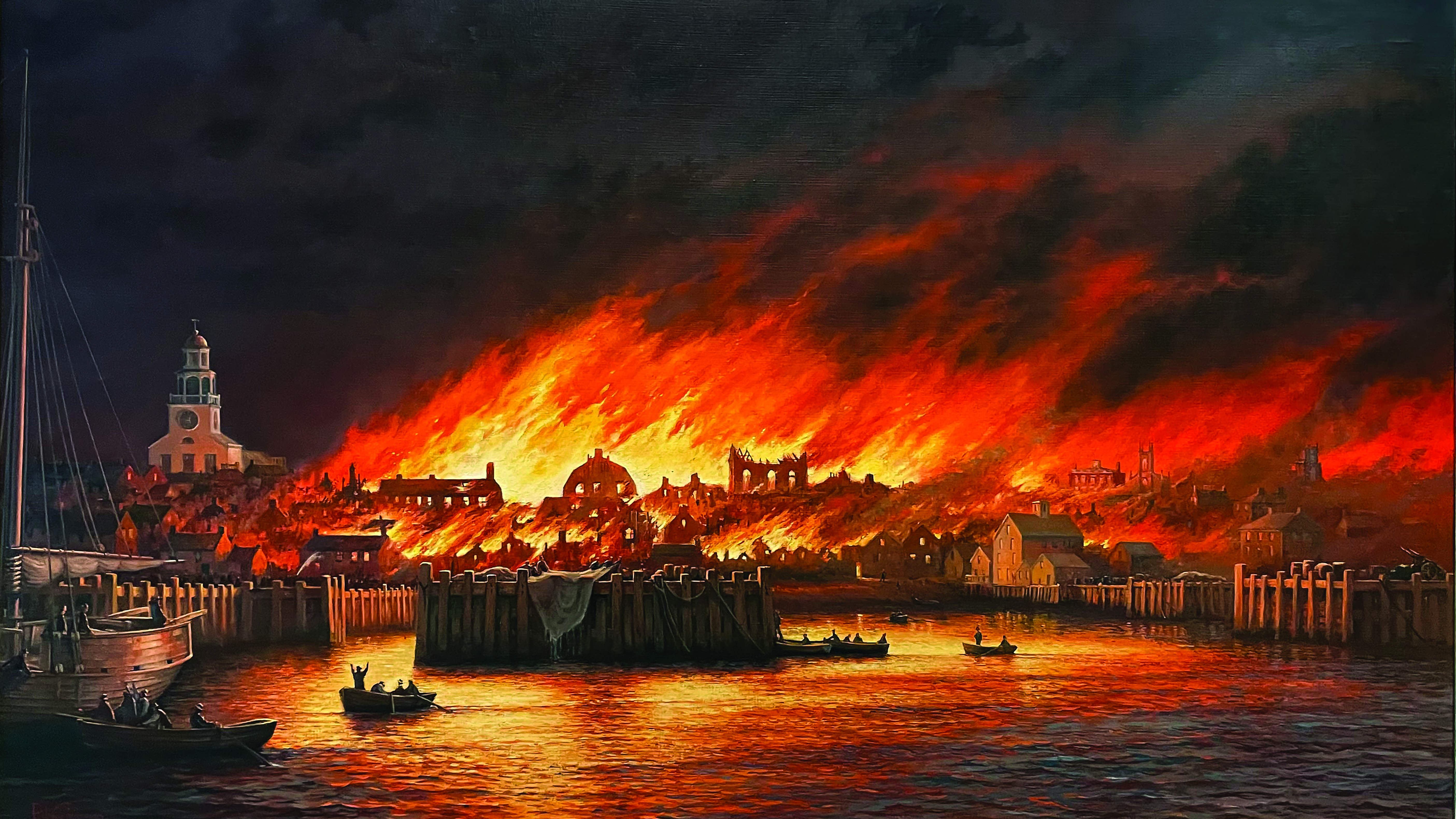Inferno transforms Nantucket from whaling mecca to seaside resort
Swabbies in the U.S. Navy of the mid-1800s coveted coastal survey duty. Crews doing this work mapped such details as depths, shallows, obstructions, and tides along the American coasts. Survey duty meant regular shore leave, fresh food, and slim chances of combat. On Monday July 13, 1846, the crews of cutter USS Gallatin and schooner USS Wave completed a day of surveying the waters off Woods Hole, Massachusetts, and Martha’s Vineyard, a large island 13 miles from Cape Cod’s south shore. Sailing east, the warships anchored outside the harbor at Nantucket, the main town on an island of the same name about 35 miles east of the Vineyard. Around midnight, a sailor standing watch noticed a glow over Nantucket. The seaman alerted his superiors that the 48-square-mile island seemed to be on fire.
The Wampanoag, Nantucket’s aboriginal natives, had long scavenged the remains of beached whales for oil, meat, and bone to make tools. In the late 1600s, the island began to attract members of the Society of Friends. When Quakers came to New England to escape persecution in England only to encounter persecution by the region’s dominant Puritans, Quaker missionaries encouraged coreligionists to relocate to Nantucket, which was home to no organized sect. Nantucket’s first Quaker meeting established itself in 1708. As more and more Friends took up residence, the Wampanoag passed along their whale-scrounging skills.
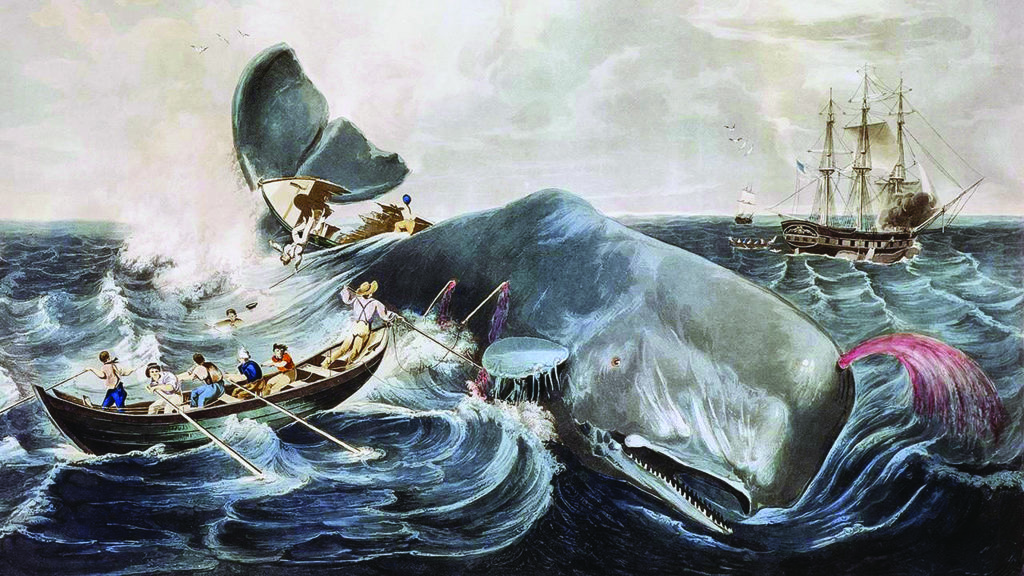
Quakers, who lived simply and dressed plainly, opposed war, drink, and, sometimes, slavery. They were industrious, establishing banks, businesses, and philanthropies as well as founding on a Nantucket harbor opening to the northwest a town they initially called Sherburne.
Soon rudimentary three-and four-story buildings lined Sherburne’s narrow streets. Other towns and fishing villages, including Siasconset, eight miles east, took root. By 1742, the island’s Quaker population numbered 2,400.
From beachside carrion-picking, islanders progressed to sailing the globe in pursuit of live whales, which could weigh 65 tons. Setting off from ocean-going ships in rowboats, whalers ambushed surfaced cetaceans, hurling barbed lances called harpoons and fixed to a whaleboat with a stout line paid out around a hub. A successful strike set off a “Nantucket sleigh ride,” as the wounded animal dove, not infrequently dragging its tormenters to their doom. In 1820, Nantucketer George Pollard was captaining the whaleship Essex when a sperm whale stove in his ship’s bow and sank it. After the whaler Two Brothers wrecked in 1823, killing his seagoing career, Pollard retired to a job as one of his hometown’s night watchmen.
Whaleships were floating factories. Upon slaying an animal, a crew, which could number 40, secured the enormous carcass to the hull. Deploying long-handled bladed tools known as flensing knives, men removed blubber, or fat, in strips.
Rendered in cauldrons, the whale flesh was boiled into oil prized for use in cooking and illumination. The oil went into barrels, each capable of holding 35 to 40 gallons. An average whaling ship held 1,200 barrels.
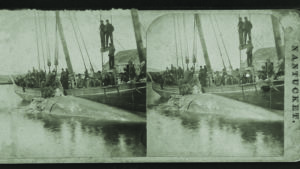
Another byproduct was spermaceti, a waxy product of a cranial organ whales use to control their buoyancy and gauge direction. Spermaceti, an excellent lubricant for fine machinery, made candles that burned brighter, longer, and without smoke. Ambergris, generated by the mammal’s digestive tract, went into perfume. Roaming the globe—a voyage could exceed three years—Nantucket whalers made their home port the prosperous center of a robust industry. Warehouses storing barrels of whale oil became fixtures along the town docks, as did enterprises—coopers, chandlers, sailmakers, provisioners, shipwrights, and rope walks where line was made by workers twisting together strands of hemp as they strode—found in any industrial harbor. In 1795 residents renamed Sherburne for the island. During the American Revolution and again when war with Great Britain erupted in 1812, Nantucket declared itself neutral. One motivation was Quaker pacifism. Another was money, which did not last. Whaling suffered a decline, as did Nantucket’s fortunes (“Boom and Bust,” p. 30). By mid-century, the island, home to 8,000, was a genteel backwater with multiple churches, a nationally acclaimed library called The Atheneum, and three newspapers: The Daily Warder and the weekly Nantucket Inquirer and Nantucket Weekly Mirror. Pacific Bank cashier William Mitchell and his daughter, Maria, were noted amateur astronomers whose celestial observations were critical to coastal surveys. William built an observatory atop the bank. Maria cataloged the Atheneum’s collections. Nantucket still was home to spermaceti candle factories, ropewalks, sailmakers, and blacksmiths. Warehouses along five wharves held thousands of barrels of whale oil.
Built mainly of wood, early 19th-century American towns were tinderboxes. Residents feared flames—but they also feared firefighters, given fire squads’ ineptitude and avarice, little changed from the time of Marcus Licinius Crassus. In Rome of the last century B.C.E., Crassus would arrive at a blaze with his 500-man force and offer to buy the property for a pittance. If the owner accepted, the crew doused the flames and Crassus added to his immense holdings on the cheap. If the property owner refused, the building burned. So too with American firefighting units of the early 1800s; after a fire squad’s visit, it was not unusual for possessions to be missing. Firefighters stopped flames by smothering them with earth or spraying water delivered by bucket brigade and later wheeled pumper. Another tool for containing fires was gunpowder, used to blast firebreaks by knocking down flammable buildings. Every residence maintained a leather bucket bearing the name of the property’s owner, whose family was expected to help fight blazes.
Flames were a scourge of urban life. On April 10, 1845, a fire consumed a third of Pittsburgh, Pennsylvania. That July, a New York City candle factory caught fire; 345 buildings burned, 30 people died, and looting broke out. Damages nearing $10 million could have been far worse; New York recently had begun requiring new construction to be of brick, masonry, and iron.
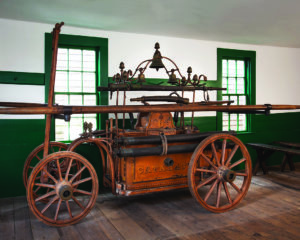
Nantucket was a standard American municipality, with little regulation and minimal public services. Firefighting was largely private and makeshift. An 1836 blaze that started at 4 Main Street consumed the Washington House hotel and neighboring structures but was held to $50,000 in damages because residents pitched in. Seeking a better system, in 1838 the town’s seven-member Committee of Selectmen chartered the Nantucket Fire Department. A board of three, led by the chief director and a clerk, was to oversee the department. The town was divided into 20 fire districts led by officials called wards. Each ward was to identify buildings to demolish with gunpowder in a fire emergency.
The charter called for the creation of ten independent fire companies of 45 volunteers apiece led by a captain. Each company was to be outfitted with a hand-pumped wheeled water engine, fed by cisterns strategically located around the harborside business district, like the one in front of the Pacific Bank. Rainwater from building downspouts topped off the cisterns, which had hand-cranked pumps and leather hoses for supplying fire wagons; to reach distant fires, wagons could be linked by hoses.
Except for five prominent brick structures—Philip Folger’s house, Jared Coffin’s house, Aaron Mitchell’s mansion, the town offices, and the Pacific Bank—Nantucket’s business district was all wood, and its streets no wider than in Sherburne days—30 to 40 feet across. On June 2, 1838, a ropewalk caught fire. Men rolled barrels of oil into the harbor, only to have flying embers ignite the resulting slick. The blaze destroyed 20 houses and businesses, inflicting more than $100,000 in damages. After the fire department deftly handled an October 1840 candle factory fire, however, minutes taken of a Selectmen’s meeting suggested Nantucket enjoyed sufficient fire protection. In 1846, the selectmen allocated a $2 annual stipend for each fireman, with a 50 percent increase to apply in 1847.
The summer of 1846 was very dry. Monday night, July 13, was warm and windy. The moon was full. However, Nantucket was dark. Islanders thought streetlights too costly. The business district was quiet except for late doings at William H. Geary’s hat shop at 4 Main Street. To heat irons for flattening felt brims, Geary kept a coal stove going year-round. The vent pipe pierced his shop’s ceiling. On the second floor, the stovepipe, enclosed in wood, elbowed into a chimney. Finishing work that Monday night, Geary checked his stove for embers and sparks. Finding none, he closed up shop around 9 p.m. Around 11 p.m., a watchman in the south tower of the Unitarian Church on Orange Street spotted smoke over Main Street and shouted “Fire!” Passersby entered the hattery. Finding the wall behind the chimney hot, they soaked it with water. The wall collapsed, revealing flames rising into the adjacent building.
The crews of two water engines, the No. 6 Cataract and the No. 8 Fountain, arrived simultaneously. Deciding they needed a double-pumper arrangement, the captains debated whose engine would spray and which would pump from the cistern. While the captains, William H. Farnham of No. 6 and William C. Swain of No. 8, dithered, the blaze spread. By the time Cataract began spraying the hattery, the fire was out of control.
“At the outset, a smart stream of water would have quenched the fire in the Geary store,” a witness said later.
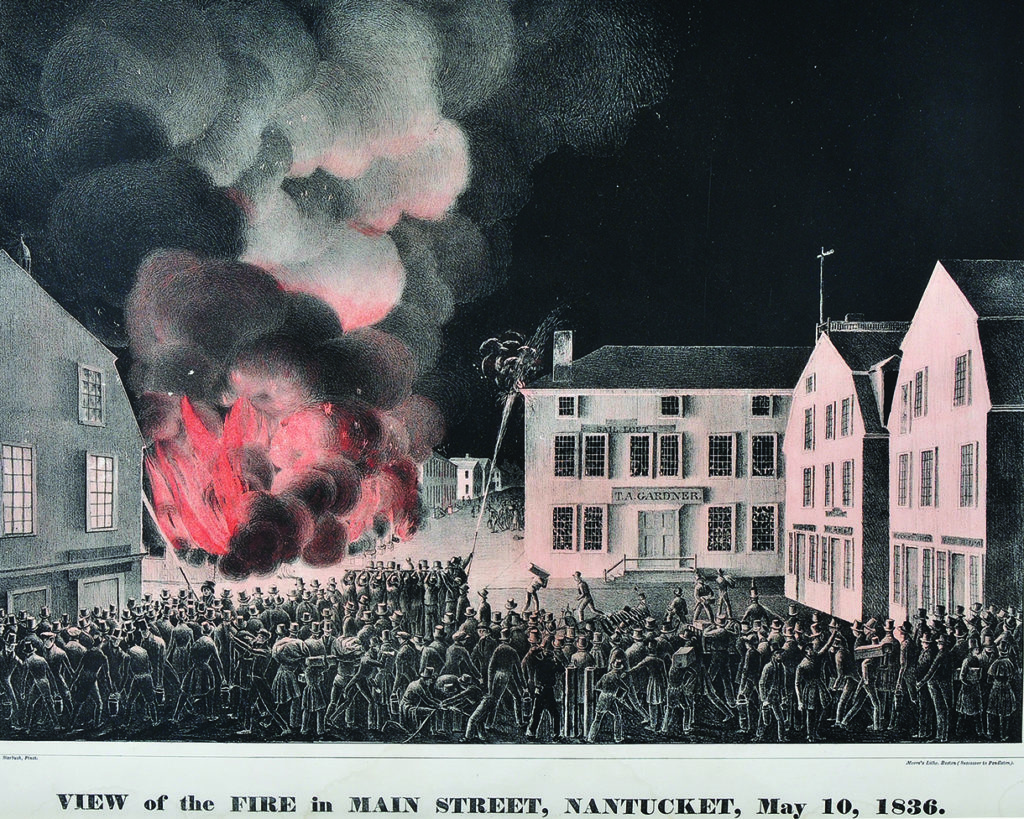
Flames spread east to Union Street, leaped Washington Street, and consumed Joseph Hamblin’s hayloft. A flaming tendril snaked west, nearing Orange Street, where Philip Folger’s brick house momentarily checked the blaze. The fire directors and wards decided to demolish buildings, starting with Dr. Nathaniel Ruggles’s house, just in from the corner of Main and Orange.
Gravitating north, the fire immolated every wooden building in its path. The crew of No. 4 engine, the Deluge, could not draw water from a cistern. Flames destroyed the rig. The wind rose. An updraft became a fiery vortex that shot a fireball from the corner of Federal and Main over seven streets to land on North Water.
Some Nantucketers bribed firefighters to save possessions, weakening the fire line. Residents hitched cartloads and let their horses gallop. Others draped waterlogged carpets over their houses’ roofs. The improvised defense did not work well.
Navy captains Lieutenant Charles H. Davis of Gallatin and Lieutenant John R. Goldsborough of Wave ordered their crews into town. As the fire was nearing The Atheneum on Federal Street, sailors, library workers, and patrons moved the building’s contents three times. The building and the collection within were lost. Sailors wrested the Pacific Bank vault’s contents out of harm’s way. Water from the cistern out front mostly saved the bank’s wooden exterior but its rooftop observatory and astronomy equipment burned.
Adjacent to the Pacific Bank, the wooden-pillared facade of the Methodist Church caught fire. The wards decided to sacrifice the chapel. Seamen emplaced kegs of gunpowder. According to island lore, Maria Mitchell argued against demolition; the wind was blowing away, she said. The fuses went unlit. The Methodist Church survived. Trinity Episcopal, just inside the corner of Broad and Centre Streets, did not. Built of wood plastered to suggest stone, Trinity went up quickly, its bell tolling as flames collapsed the belfry.
News-minded Martha Washington Jenks ran to the Daily Warder office to set and print an account of the fire, figuring to distribute broadsheets to departing vessels in the morning, if they saw morning, so news of the fire would reach the mainland.
The crew of No. 5 water engine, the Nantucket, abandoned their machine at E.W. Gardner’s Candle and Oil Factory. The engine itself went up. Flaming oil badly burned the captain. Along the harbor, barrel after barrel of whale oil exploded. Stored rope, canvas, lumber, and candles fueled the blaze. “One of the peculiar incidents of that wild night was the rare sight of the harbor on fire,” Fred Elijah Coffin recalled. “Many barrels of whale oil on the wharves had burst, and their contents flowed over the water of the harbor and there, taking fire, presented the grand spectacle of a sea of fire.”
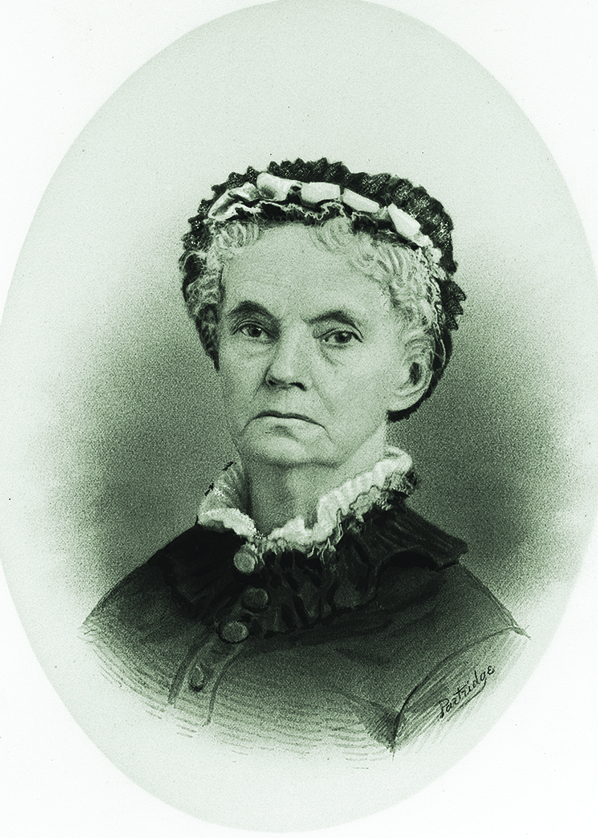
Four wharves burned; only Commercial Wharf survived. Coffin said he saw bystanders on Old North Wharf trapped “between the devil and the deep blue sea” until boatmen rescued them. A man in Siasconset reported that around 1 a.m. a cannonade-like boom roused him to see the “heavens were red with fire.” Residents of Falmouth, 32 miles northwest on Cape Cod, could see the flames.
The town’s few brick structures and the Atlantic stopped the fire’s spread. As dawn was breaking Tuesday, firefighters and residents, exhausted and grimy, gathered at the Pacific Bank. Where once had stood 33 acres of homes and businesses, nothing blocked the view of the smoking harbor. More than 300 structures had burned. A thousand Nantucketers were homeless but none had died. Martha Jenks distributed her summary of the fire to ships raising sail. Residents assessed the damage at $1 million—today, $31 million. The Selectmen set aside $5,000 in town funds to go to the worst off. The blaze destroyed two engines and hoses and cistern pumps worth $3,000. Demolishing 20 buildings, the town had run out of gunpowder. The Selectmen swore in additional constables to discourage looting and keep the peace, and on July 15 drafted an appeal sent to Boston, New York, and other cities:
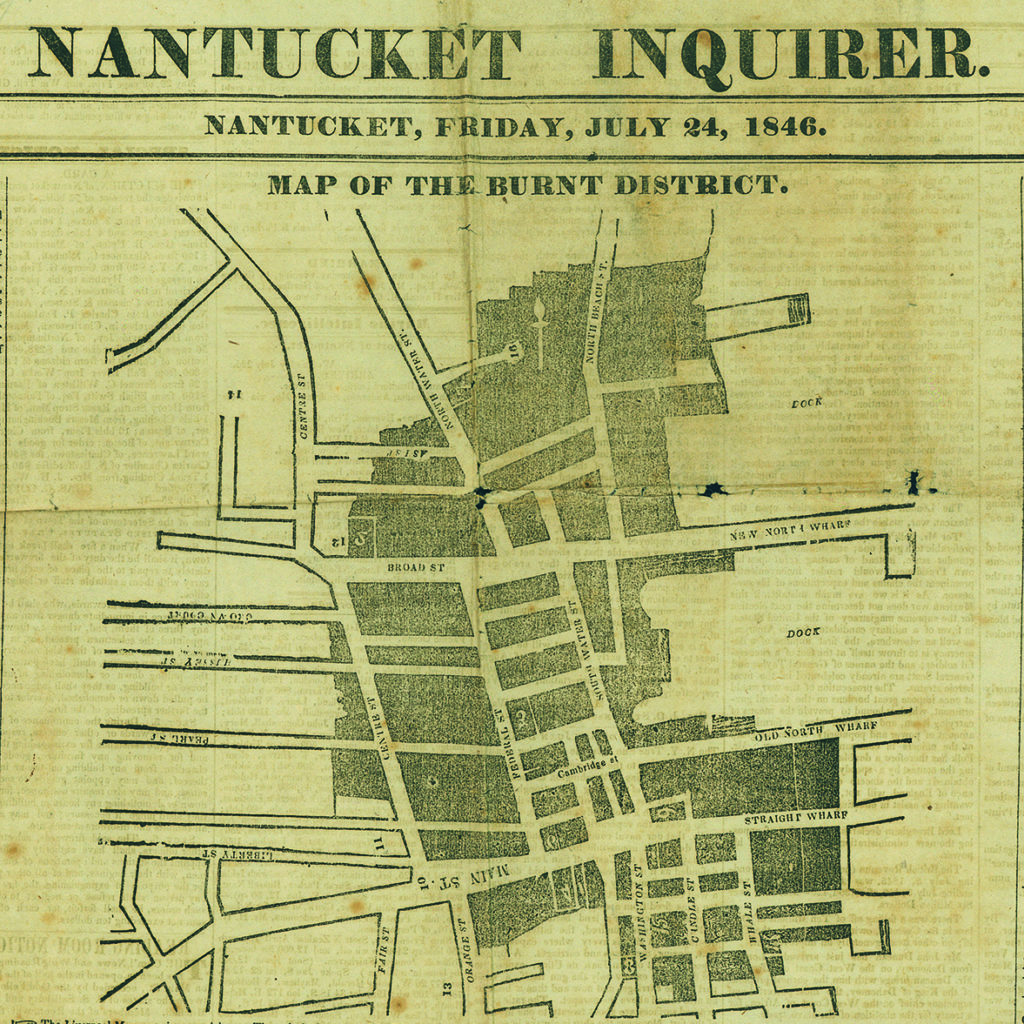
“Friends—The undersigned Selectmen of the Town of Nantucket, have been constituted…to ask at your hands such aid as you may feel able to render to our unfortunate and distressed people. One-third of our town is in ashes. A fire broke out on Monday evening last, a few minutes before eleven o’clock and raged almost uncontrolled for about nine hours…We need help—liberal and immediate. Please direct anything which you may send to the Selectmen of the Town of Nantucket, and we pledge ourselves to dispense whatever you may bestow, faithfully, and to the best of our ability, judiciously.”
A donation of $330 from church congregations in Charlestown, Massachusetts, arrived on July 21. The city of Troy, New York, sent 21 stoves. Steamship Bradford Durfee sailed from Fall River, Massachusetts, carrying over $1,000 cash and nearly $3,000 worth of food and other essentials. Nantucket received $6,400 in goods and $56,498 in cash. A committee worked up a more fire-resistant street grid that the Selectmen approved on August 14, 1846. The revised city layout eliminated Independent Lane, Coal Lane, Brown’s Lane, and Black Horse Lane. Through purchase of land by eminent domain at $7 to $23 per 16’5” measure, the safer grid doubled the width of the seven major downtown streets. On paper, Federal Street now measured 60 feet across; Broad Street, 55; and Main Street 92 feet, narrowing to 80 feet as the roadbed turned east. The street plan, including plotting, grading, and paving, was implemented within six months, under budget. The Selectmen encouraged residents to rebuild in brick; more than 60 did so.
Nantucketers submitted loss claims. Selectman Charles C. Coffin kept the ledger, disbursing donated funds to 533 recipients. George Pollard, the unlucky former whaling captain and night watchman—he had not been on duty the night of the fire—received $50. Most petitioners were disappointed. Peleg West, 75, filed for $3,183; he got $450 in cash and provisions. Only Lydia Ruggles, 13, was paid her entire loss claim; she requested $100. The town officially hailed the U.S. Navy for its sailors’ “unremitting exertions,” as did Navy Secretary George Bancroft.
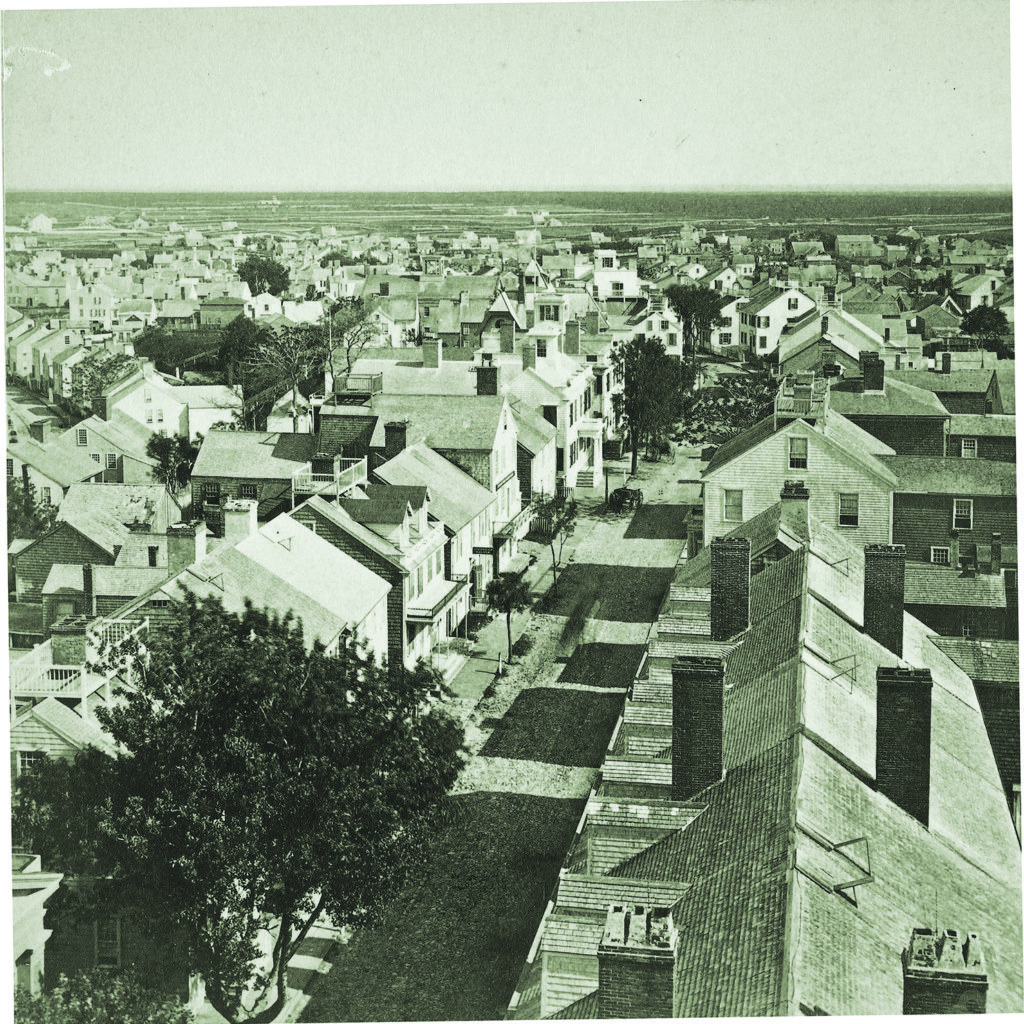
The three papers carried classifieds pleading for the return of property “lost” during the fire. Samuel Jenks complained that many men acted with an “appalling lack of civic responsibility.” Nantucketers spoke ill for years of neighbors who tried to profit from the blaze. A February 8, 1847, analysis criticized the two fire companies whose members lost their engines and the citizens and firefighters who, amid the disaster, sought private enrichment. The report also obliquely blamed the No. 6 engine’s captain for “refusing to obey a fire ward.” The report recommended better training for fire wards and a fire department reorganization.
The loss of The Atheneum weighed heavily. “Many were the sighs and heavy hearts, as we gazed on the ruins of that favored institution, as in the general distress, what was there to hope for in the future, as far as the rebuilding of any building was concerned?” William Macy wrote. Rebuilt of wood and rededicated on February 1, 1847, the library received donated books from every state, as well as manuscripts and other curios. Appearances at the new building by star speakers like Ralph Waldo Emerson, Horace Greeley, and Lucretia Mott helped restore The Atheneum to national prominence.
Investigators attributed the Great Fire of Nantucket to that wooden soffit enclosing hatmaker William H. Geary’s stovepipe elbow. Among urban fire scapegoats, the hatter escaped the infamy heaped upon the Emperor Nero for burning Rome in 64 C.E. and Mrs. O’Leary’s cow for starting the Great Chicago Fire of 1871. If there was a villain, he was William H. Farnham, captain of No. 6 engine, the Cataract, and, surprisingly, grand marshal of a commemorative July 13, 1847, Nantucket parade.
By 1896, however, Farnham’s star had grown tarnished. “It has always been claimed by many that but for the obstinacy of the Cataract Engine Company, the flames could never have gone beyond that store (Geary’s),” the editors of the merged Nantucket Inquirer and Mirror wrote on the 50th anniversary. In a letter to the editor, Farnham’s son Joseph affirmed his father’s culpability. “The Cataract No. 6 and the Fountain No. 8 reached the cistern about the same time,” the son wrote. “An argument arose between the ‘skippers’ of the two engines as to who should drop the suction hose into the cistern. My father, captain of the No. 6 was…critically blamed for this most unfortunate condition.”
Nantucket approached rebuilding as it once had taken to whaling, diligently and methodically. In a 1917 timeline, the Inquirer and Mirror recorded the nadir of the island’s decline as 1870. Still, the isle remains legendary for its whaling past. Although the author Herman Melville never visited Nantucket before publishing Moby-Dick in 1851, he had briefly worked aboard a whaler, and found inspiration in the 1820 sinking of the Essex for his masterpiece, which enjoyed popularity in the early 1900s that continues today. The same is true of the island itself, although traces remain of yesteryear. The island’s fire department, for example, still prohibits open fires anywhere on Nantucket.
_____
Boom and Bust
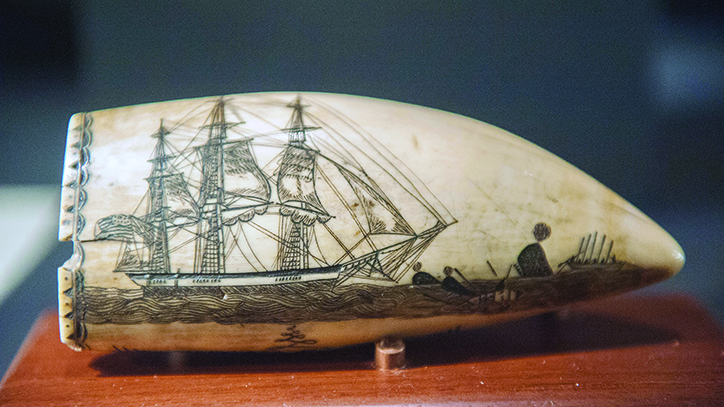
Legend dates the start of modern whaling off Nantucket to 1712, when a gale blew a Captain Hussey and crew out to sea and into a pod of sperm whales, a few of which the men captured. Whaling soon was an island trade. By 1775, Nantucket was the third-largest municipality in Massachusetts, trailing only Salem and Boston. In 1820, Nantucket’s whaling fleet numbered 150 vessels. Owing to the emergence of kerosene as a fuel and to competition from railroad-accessible mainland ports like New Bedford and Sag Harbor, New York, whaling began to pall on the island in the 1830s, a trend worsened by a sandbar that kept larger whalers out of Nantucket Harbor. The Great Fire destroyed the island’s trades necessary for whaling, deflecting immigrants first to mainland ports, then to the California gold fields and Colorado silver mines. By 1853, Nantucket’s fleet comprised 15 whalers. Discovery of petroleum at Titusville, Pennsylvania, in 1859 put Nantucket whaling into a death spiral that the Civil War concluded; 400 Nantucket men joined the Union Army. Confederate commerce raiders left Nantucket’s meager fleet all but inert. The last whaler left Nantucket in 1869; abandoned hulks dotted the harbor. By the early 1900s, American commercial whaling had petered out. The United States banned the trade in 1971, a stricture eased for the Makah of the Pacific Northwest, for whom whaling remains sacramental, and subsistence whaling by tribes in Alaska. Whaling survives on Nantucket in mementoes such as scrimshaw carvings like the one at left (nha.org/visit/museums-and-tours/whaling-museum). —Paul F. Bradley
_____
Pleasure Island
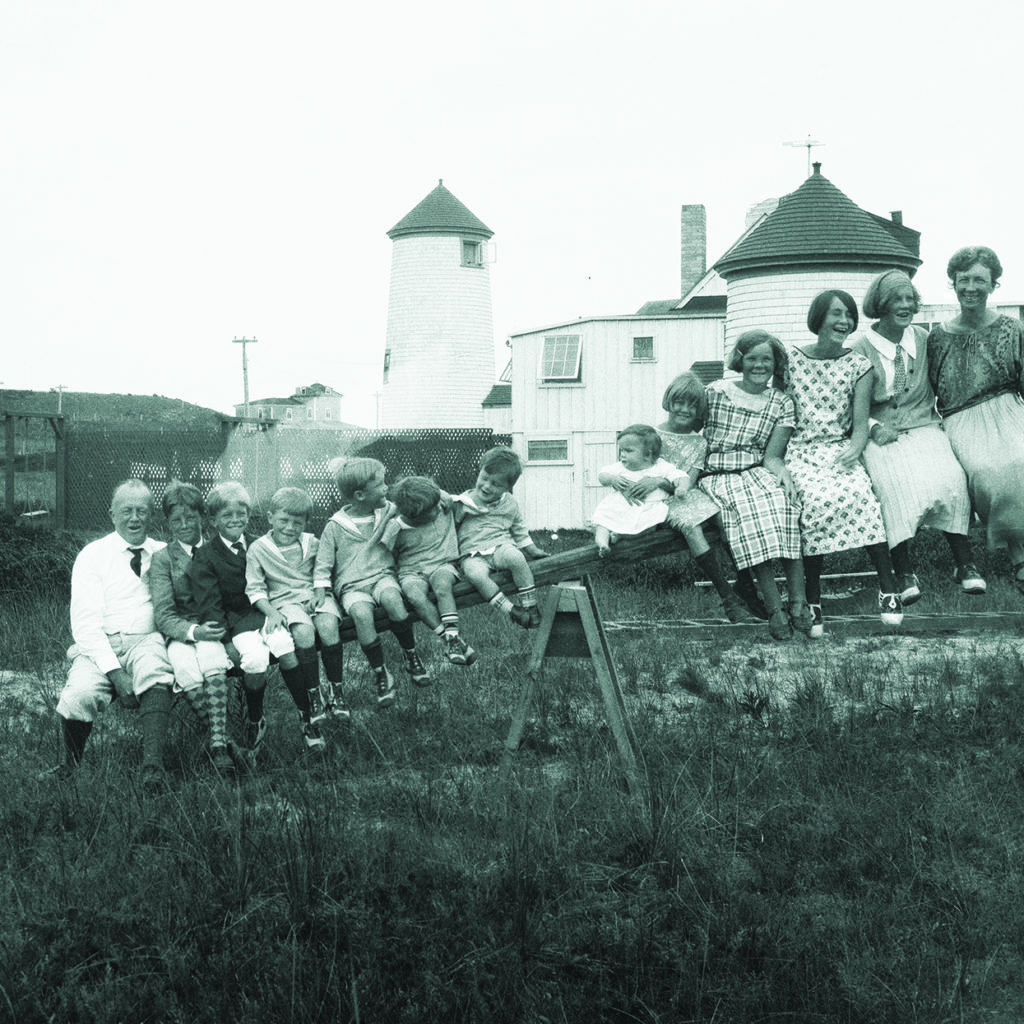
As early as 1828, Nantucket, to some islanders’ disdain, was trying to lure vacationers. As whaling was declining, silk, stove, and straw-hat manufacture and other enterprises proved neither lucrative nor sustainable. The Great Fire sent the population into freefall; the 1870 census counted 4,123 year-round residents; much larger Martha’s Vineyard, 30-some miles west, was home to only 3,787 but doing a robust touristic trade. Nantucketer Frederick Coleman Sanford—merchant, bank president, raconteur—began to promote the island in the press, romanticizing old Nantucket in tales of “Sea King” captains and their brave crews. Emulating purpose-built Vineyard resort town Oak Bluffs, Nantucket began to market itself. When Presidents Ulysses S. Grant and Chester A. Arthur visited, Sanford was their guide. Lower income families left the island, but power brokers stayed, putting old money to work building restaurants, hotels, guesthouses, and other attractions. Articles in Harper’s Magazine and Scribner’s touted the Nantucket experience. Celebrities like Frank Gilbreth, efficiency expert and subject of the best-seller Cheaper by the Dozen, at left with his family, began summering on the island. Buildings raised in the town of Nantucket after the blaze aged into a time capsule of small-town life. The seasonal economy galloped into the post-1945 decades through to the present day. Real estate became the new whale oil. As of September 2019, the median home price on Nantucket was $1.7 million. —Paul F. Bradley
This story appeared in the February 2021 issue of American History.

